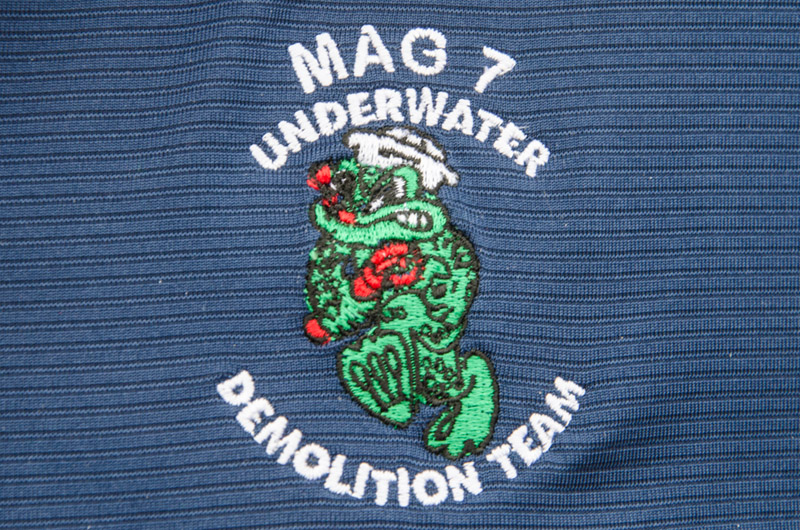They still wear a uniform, of sorts, to identify their place in military history.
They were once among the fittest of elite Navy forces, and their waistlines are still pretty trim. They have all had impressive careers beyond the Navy, and they have never forgotten what they went through.
Six members of the original Navy SEALs Team One gathered recently at the Chilmark home of Will Sawyer, to catch up, tell the old stories and revel in the camaraderie of service to country.
These days, the uniform is a navy blue polo shirt with an American flag on the sleeve.
As they lined up for a group picture on a deck overlooking Squibnocket Pond, they stood military straight.
“The main thing is, we’re still standing,” said former SEAL Martin McNair with a laugh.
President John F. Kennedy, a celebrated Navy veteran, established the SEAL teams in 1962 to carry out secret missions. “The Navy needed a commando unit like the Army special forces,” recalled former SEAL Martin McNair.
About 400 enlisted men and 47 officers entered the first training class at the Naval Amphibious Base in Coronado, Calif. About 40 of the enlisted men, and seven of the officers made the rigorous grade.
“The training that we had to go through,” said former SEAL Pete Witter, “the fact that seven of us made it, you get pretty close.”
Informally and without a hint of arrogance, they called themselves The Magnificent Seven, sometimes shortened to Mag 7. The name came from the title of a popular western movie released in 1960 — coincidentally released as a remake last weekend.
Some already had Navy training as underwater demolition team specialists. They were trained to find and destroy enemy defenses on shorelines, as well as scout underwater obstructions like reefs or rocks, just before troops staged an amphibious landing.
It was tough, dangerous training, and they all knew what they were in for when they signed up.
“We had to go in a helicopter and jump in the water, which sounds easy,” Mr. Sawyer said.
It wasn’t easy. The choppers, primitive by today’s standards, had to fly fast, 20 feet above the ocean, dealing with changing conditions. The altitude changed as seal trainees jumped out and lightened the helicopter, causing the aircraft to fly incrementally higher until the last few jumpers were dropping 40 feet to the water. Some died trying to master the difficult training.
“The old helicopters had an altimeter, but it didn’t work very well,” Mr. Sawyer said.
The equipment they used was the most advanced technology of the day, but it seems rudimentary by today’s standards. Still, they accomplished missions that seem implausible, even today.
“We had to learn how to rendezvous with a submarine underwater,” Mr. Sawyer said.
There are some things they still can’t talk about, and some things they couldn’t talk about then, but can talk about now. But they are mostly circumspect about their service.
Most were deployed in Viet Nam as part of a covert plan to head off escalation of military conflict. There are regrets about the Gulf of Tonkin incident, a naval skirmish off the coast of North Viet Nam. History has judged the incident harshly, rooted as it was in mistaken intentions, misinformation and domestic politics. The incident served to escalate the conflict, before their mission had a chance to unfold.
Some were career Navy men; others got out of the service and went on to accomplished careers.
Mr. Sawyer founded a corporation that raises funds for educational institutions. Mr. Witter is a retired architect. William White is a commercial real estate developer in Hawaii. Perry Wootten became a Presbyterian minister, serving at a church in the Bronx.
Mr. Wootten began the week as the guest minister at the Chilmark Community Church.
Not surprisingly, the group spent much of their time in, on or near the water. They got in some fishing, went kayaking, cruised aboard the schooner Alabama, and managed some ocean swimming.
One evening, they even watched The Magnificent Seven (the 1960s version).
They are still a competitive bunch. After lobster and chowder Wednesday evening, they finished a weeklong croquet tournament.
“We felt very blessed to all gather together with our wives,” Mr. Sawyer said.
The six remaining members of the Magnificent Seven took time also to remember former SEAL John Boyd, who died in 2013.
Next year, the group plans to gather on Coronado Island, the place where they first met and learned how to be Navy SEALs, more than five decades ago. Over all those years, their bond has remained unshakable, renewed year by year when they meet for a reunion.
“We served together, and took care of each other,” Mr. Wootten said. “Everybody has gone in different directions, but we all manage to come together.”





Comments (21)
Comments
Comment policy »